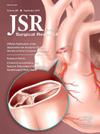肛门发育不良中PIK3CA突变的检测。
IF 1.7
3区 医学
Q2 SURGERY
引用次数: 0
摘要
简介:尽管肛门发育不良是肛门癌的前兆,但肛门癌的发病率正在增加。一旦确定了肛门发育不良,预测哪些患者进展为肛门癌的风险最高仍然具有挑战性,因为没有风险分层的分子生物标志物。肛门癌中最常见的突变影响到磷脂酰肌醇(3,4,5)-三磷酸激酶(PI3K)的催化亚基。我们试图确定在癌前肛门病变中是否可以检测到PIK3CA突变。方法:从福尔马林固定、石蜡包埋的肛门组织切片中提取DNA。采用数字聚合酶链反应检测每个样本是否存在三种最常见的PIK3CA突变:E545 K (c.1633)G > A), h1047r (c.3140A > G)和h1047l (c.3140)A bbbbt)。比较突变数据、组织学和人口学数据。结果:我们分析了来自68例肛门疾病患者的124个组织样本。其中e545k阳性40份,h1047r阳性3份,h1047l阳性2份。PIK3CA突变在8/42(19%)的低级别非典型增生样本、14/45(31%)的高级别非典型增生样本和20/37(54%)的癌症样本中检测到。在单样本分析中,突变的存在与较高的疾病等级相关(P = 0.004)。结论:PIK3CA突变可以在肛门组织样本中检测到,并且随着疾病级别的提高,发病率也会增加。我们的研究结果为进一步评估PIK3CA突变作为鉴别肛门发育不良患者进展为肛门癌风险最高的生物标志物提供了依据。本文章由计算机程序翻译,如有差异,请以英文原文为准。
Detection of PIK3CA Mutations in Anal Dysplasia
Introduction
The incidence of anal cancer is increasing despite screening and treatment options for anal dysplasia, the precursor to anal cancer. Once anal dysplasia is identified, predicting which patients are at the highest risk of progressing to anal cancer remains challenging, as there are no molecular biomarkers for risk stratification. The most common mutation in anal cancer affects the catalytic subunit of Phosphatidylinositol (3, 4, 5)-trisphosphate Kinase (PI3K). We sought to determine if PIK3CA mutations are detectable in precancerous anal lesions.
Methods
DNA was extracted from formalin-fixed, paraffin-embedded anal tissue slides. Digital polymerase chain reaction was performed to test each sample for the presence or absence of three of the most common PIK3CA mutations: E545 K (c.1633 G > A), H1047 R (c.3140 A > G), and H1047 L (c.3140 A > T). Mutation data, histology, and demographic data were compared.
Results
We analyzed 124 tissue samples from 68 unique patients across the spectrum of anal disease. Forty of these samples were E545 K positive, three were H1047 R positive, and two were H1047 L positive. PIK3CA mutations were detected in 8/42 (19%) low-grade dysplasia samples, 14/45 (31%) high-grade dysplasia samples, and 20/37 (54%) cancer samples. The presence of a mutation was associated with higher grade of disease on per-sample analysis (P = 0.004).
Conclusions
PIK3CA mutations can be detected in anal tissue samples across the spectrum of carcinogenesis with increasing incidence with higher grade of disease. Our results warrant further evaluation of PIK3CA mutations as a biomarker for identifying patients with anal dysplasia at highest risk of progression to anal cancer.
求助全文
通过发布文献求助,成功后即可免费获取论文全文。
去求助
来源期刊
CiteScore
3.90
自引率
4.50%
发文量
627
审稿时长
138 days
期刊介绍:
The Journal of Surgical Research: Clinical and Laboratory Investigation publishes original articles concerned with clinical and laboratory investigations relevant to surgical practice and teaching. The journal emphasizes reports of clinical investigations or fundamental research bearing directly on surgical management that will be of general interest to a broad range of surgeons and surgical researchers. The articles presented need not have been the products of surgeons or of surgical laboratories.
The Journal of Surgical Research also features review articles and special articles relating to educational, research, or social issues of interest to the academic surgical community.

 求助内容:
求助内容: 应助结果提醒方式:
应助结果提醒方式:


